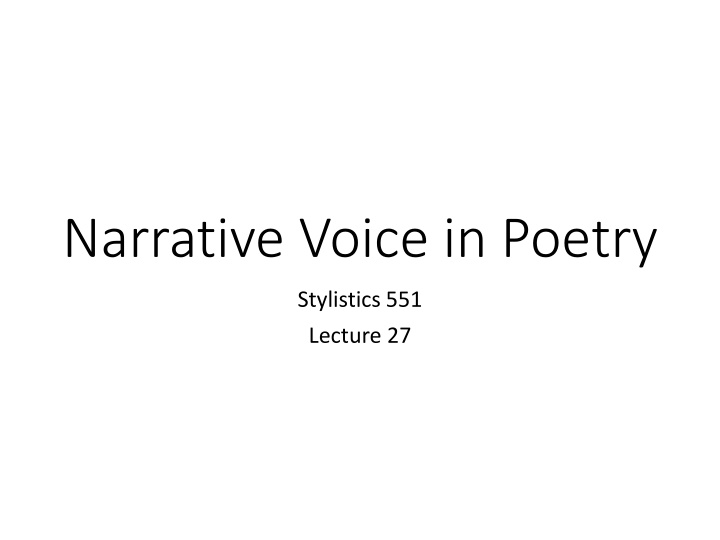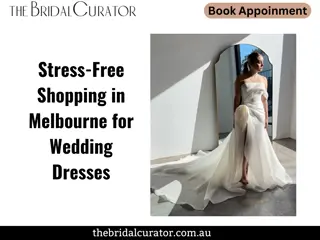
Unveiling Narrative Voice in Poetry: Stylistics Lecture Insights
Explore the essence of narrative voice in poetry through an in-depth analysis of the speaker, plot, and different types of narrators. Uncover the significance of narrative poetry and how poets skillfully craft stories within poetic constraints. Dive into the world of narrative poems, from epics to ballads, and grasp the various narrative perspectives that shape literary masterpieces.
Download Presentation

Please find below an Image/Link to download the presentation.
The content on the website is provided AS IS for your information and personal use only. It may not be sold, licensed, or shared on other websites without obtaining consent from the author. If you encounter any issues during the download, it is possible that the publisher has removed the file from their server.
You are allowed to download the files provided on this website for personal or commercial use, subject to the condition that they are used lawfully. All files are the property of their respective owners.
The content on the website is provided AS IS for your information and personal use only. It may not be sold, licensed, or shared on other websites without obtaining consent from the author.
E N D
Presentation Transcript
Narrative Voice in Poetry Stylistics 551 Lecture 27
Poets have the potential to tell stories as much as any other author. A narrative consists of the sequence of events that recount a story, which is the central aspect of narrative poetry. Understanding the narrative voice in poetry involves following the plot and analyzing the speaker. Considering all aspects of the narrator helps readers understand how the poet sketches characters within the confines of poetic style.
Narrative Poetry Narrative poems are those that have a plot. Certain poetic styles, such as epics and ballads, traditionally feature a story. Epics are very long poems that describe the actions of a heroic character, usually making history as in the case of Homer's "Iliad." Ballads are narrative songs that traditionally follow the format of rhymed quatrains, or four-line stanzas. The usually anonymous folk ballads recount a centralized dramatic event, such as a man's labor beating a machine's. Narrative poetry spans as far back as the Homeric epics of antiquity, through medieval ballads to modern poetry.
Speaker The narrator tells the story in the poem, giving the speaker a voice. Three types of narrators exist. With one the speaker participates in the story, perhaps as the main character. Conversely, the narrator might not participate but is present at the time and tells what he observes. Lastly, the speaker may be completely outside the story.
Narrators also have different points of view. Narrators speaking of their own actions use first person. Third person narrators tell a story that happens to others. If these narrators have no insight into the thoughts of the participants, their point of view is objective. Omniscient narrators have god-like knowledge of the characters, describing their inner thoughts and feelings.
Poetry Analysis Understanding the narrative voice in poetry requires some level of analysis. Readers start by considering who the speaker is, whether the poet, a specific persona or an omniscient being. They also look at the setting, identifying where the action happens and whether it occurs during a specific time period. Literary time periods offer insight into a poem's meaning, so readers should consider whether the poem belongs to a specific era. Readers naturally follow the storyline. Narrative poetry builds by creating tension that leads to conflict, whether moral, physical or some other type. The tone of voice the poet uses to create the story also helps the reader understand the plot of the poem.
Narrative Poem Example 1 Understanding the speaker's voice requires reading examples of narrative poetry. Edgar Allan Poe describes the story of Annabel Lee in his poem by the same name; the first-person narrator participates in the story, ultimately lying down by the tomb of his lost love. It was many and many a year ago, In a kingdom by the sea, That a maiden there lived whom you may know By the name of Annabel Lee; And this maiden she lived with no other thought Than to love and be loved by me.
Example 2 The folk ballad "John Henry" relates the story of a man conquering a steam drill but dying in the process. The third person narrator in this poem has little insight into the characters, making it an objective speaker
John Henry When John Henry was a little tiny baby Sitting on his mama's knee, He picked up a hammer and a little piece of steel Saying, "Hammer's going to be the death of me, Lord, Lord, Hammer's going to be the death of me."
Example 3 . William Blake used strong narrative voice in "The Chimney Sweeper," contrasting a sing-song rhyme scheme with the grim story of a small boy forced to sweep chimneys; the rhyme scheme reinforces his youth while his first-person words build horror in the reader.
The Chimney Sweeper: When my mother died I was very The Chimney Sweeper: When my mother died I was very young young By William Blake When my mother died I was very young, And my father sold me while yet my tongue Could scarcely cry " 'weep! 'weep! 'weep! 'weep!" So your chimneys I sweep & in soot I sleep. There's little Tom Dacre, who cried when his head That curled like a lamb's back, was shaved, so I said, "Hush, Tom! never mind it, for when your head's bare, You know that the soot cannot spoil your white hair."
Voice in Dramatic Monologue Dramatic monologue in poetry, also known as a persona poem, shares many characteristics with a theatrical monologue: an audience is implied; there is no dialogue; and the poet speaks through an assumed voice a character, a fictional identity, or a persona. Because a dramatic monologue is by definition one person s speech, it is offered without overt analysis or commentary, placing emphasis on subjective qualities that are left to the audience to interpret.
The dramatic monologue as a poetic form achieved its first era of distinction in the work of Victorian poet Robert Browning. Browning s poems "My Last Duchess" and "Soliloquy of the Spanish Cloister," though considered largely inscrutable by Victorian readers, have become models of the form. His monologues combine the elements of the speaker and the audience so deftly that the reader seems to have some control over how much the speaker will divulge in his monologue. This complex relationship is evident in the following excerpt from "My Last Duchess"
My Last Duchess That's my last Duchess painted on the wall, Looking as if she were alive. I call That piece a wonder, now: Fr Pandolf's hands Worked busily a day, and there she stands. Will 't please you sit and look at her? I said 'Fr Pandolf' by design, for never read Strangers like you that pictured countenance, The depth and passion of its earnest glance, But to myself they turned (since none puts by The curtain I have drawn for you, but I) And seemed as they would ask me, if they durst, How such a glance came there; so, not the first Are you to turn and ask thus. Sir, 't was not Her husband's presence only, called that spot Of joy into the Duchess' cheek: perhaps -


